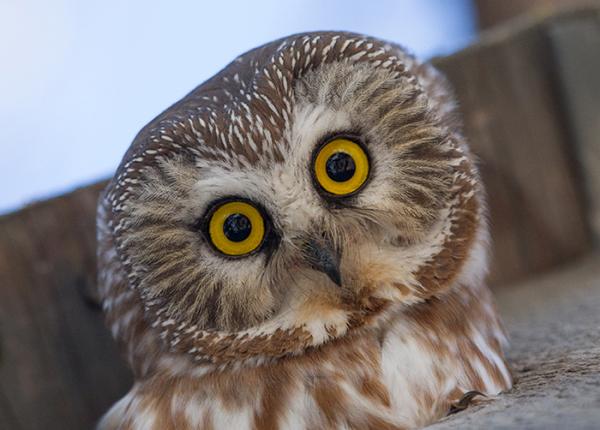From the Ojai Raptor Center
Meet adult Great Horned Owl (GHOW) Patient 24-502, affectionately nicknamed “Skunk-boy” by our hospital staff. Owls, like most other birds of prey, do not have a strongly developed sense of smell. It’s not uncommon for us to receive Red-tailed Hawk or Great Horned Owl patients reeking of skunk. At least we can assume they are less bothered by it than we are!
Aside from his skunky scent, 24-502 was admitted with eye trauma and a wing droop. Both are healing, and he has already graduated to an outdoor enclosure where his flight continues to improve daily. As you can see when GHOW 24-502 is not being physically restrained by one of our hospital technicians for an exam as he is in the first photo, he immediately takes a defensive posture of fanning out his wings and looking fierce! As apex predators, these owls need to be in order to secure their place in the ecosystem. 24-502 is obviously pretty good at striking this pose and we can’t wait to return him to the wild asap.


Ah, I see it!
The stripes make it look like a tiger leg. It does look (and is) very muscular. A bird’s chest muscles make up 15-25% of total body weight.
Oh wow that’s a lot! But I guess it makes sense since flying muscles probably are around there (please correct me if I’m wrong lol)
I will put it into context most of us will understand.
This is a chicken. Those 2 giant muscles in the middle, what we’d call the chicken breasts, are the pectorals. For us, we use them to push, as in a bench press or butterfly. For the birds, these are the flight muscles.
If you’ve carved a chicken or eaten chicken on the bone, you know the breast is by far the biggest piece. Part of that is selective breeding, so much so that the chickens we raise as food are too meaty to get very far with their wings anymore. Wild chickens (jungle fowl) can fly pretty decently for big birds.
Here’s a jungle fowl:
You’ve also seen that the chicken breast is connected to that big ridge on the ribscage, that giant, long, sturdy breast bone.
That is a huge anchor point for the muscle to counteract all that force of the flapping. With our tiny pecs, we’d tear a muscle before we got anywhere close to getting off the ground. But the bird breastbone goes from the top of the ribs to the hips. If your chest muscles were the size of your whole torso and thicker than your thighs, imagine how strong you would be!
Oh wow… That’s nuts! Thank you for the explanation!
Absowlutely!